
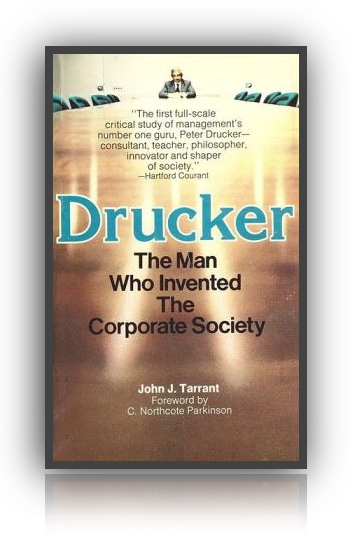
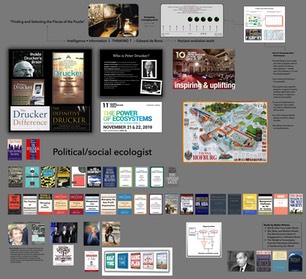
Sample Days: #sd
Daily Drucker table of contents
The topics in The Daily Drucker are attention directing tools.
Within each topic there may be individual sentences that warrant calendarization
7 MAY — A Knowledge Society and Society of Organizations
Specialized knowledge by itself produces nothing.
Post-capitalist society is both a knowledge society and a society of organizations, each dependent on the other and yet each very different in its concepts, views, and values.
Specialized knowledge by itself produces nothing.
It can become productive only when it is integrated into a task.
And this is why the knowledge society is also a society of organizations: the purpose and function of every organization, business and nonbusiness alike, is the integration of specialized knowledges into a common task.
It is only the organization that can provide the basic continuity that knowledge workers need to be effective.
It is only the organization that can convert the specialized knowledge of the knowledge worker into performance.
Intellectuals see the organization as a tool; it enables them to practice their techne, their specialized knowledge.
Managers see knowledge as a means to the end of organizational performance.
Both are right.
They are opposites; but they relate to each other as poles rather than as contradictions.
If the two balance each other there can be creativity and order, fulfillment and mission.
Managing in a Time of Great Change
Post-Capitalist Society
Organization is a tool. As with any tool, the more specialized its given task, the greater its performance capacity.
Organizations are special-purpose institutions.
They are effective because they concentrate on one task.
If you were to go to the American Lung Association and say, “Ninety percent of all adult Americans suffer from ingrown toenails; we need your expertise in research, health education, and prevention to stamp out this dreadful scourge,” you’d get the answer:
“We are interested only in what lies between the hips and the shoulders.”
That explains why the American Lung Association or the American Heart Association or any of the other organizations in the health field get results.
Society, community, family, have to deal with whatever problem arises.
To do so in an organization is “diversification.”
And in an organization, diversification means splintering.
It destroys the performance capacity of any organization—whether business, labor union, school, hospital, community service, or church.
Because the organization is composed of specialists, each with his or her own narrow knowledge area, its mission must be crystal clear.
The organization must be single-minded, otherwise its members become confused.
They will follow their specialty rather than applying it to the common task.
They will each define “results” in terms of that specialty, imposing their own values on the organization.
Only a clear, focused, and common mission can hold the organization together and enable it to produce results.
Post-Capitalist Society
28 SEP — Harmonize the Immediate and Long-range Future
A manager must, so to speak, keep his nose to the grindstone while lifting his eyes to the hills—quite an acrobatic feat.
A manager has two specific tasks.
The first is creation of a true whole (and the next topic) that is larger than the sum of its parts, a productive entity that turns out more than the sum of the resources put into it.
How To Guarantee Non-Performance
Conditions for survival
The second specific task of the manager is to harmonize in every decision and action the requirements of the immediate and of the long-range future.
sidebar ↓
This long-range future takes place within a world moving toward unimagined futures
Dealing with risk and uncertainty
History of The World In Two Hours
One thing leads to something different … which
leads to something different … which leads to
something different …
Up to Poverty
The Vanishing East
The manager and the moron (knowledge, technology, competition, time-usage …)
Luther, Machiavelli, and the Salmon
The most important challenge …
main brainroad continues ↓
A manager cannot sacrifice either without endangering the enterprise.
If a manager does not take care of the next hundred days, there will be no next hundred years.
Whatever the manager does should be sound in expediency as well as in basic long-range objective and principle.
And where he cannot harmonize the two time dimensions, he must at least balance them.
He must calculate the sacrifice he imposes on the long-range future of the enterprise to protect its immediate interests, or the sacrifice he makes today for the sake of tomorrow.
He must limit either sacrifice as much as possible.
And he must repair as soon as possible the damage it inflicts.
He lives and acts in two time dimensions, and is responsible for the performance of the whole enterprise and of his own component in it.
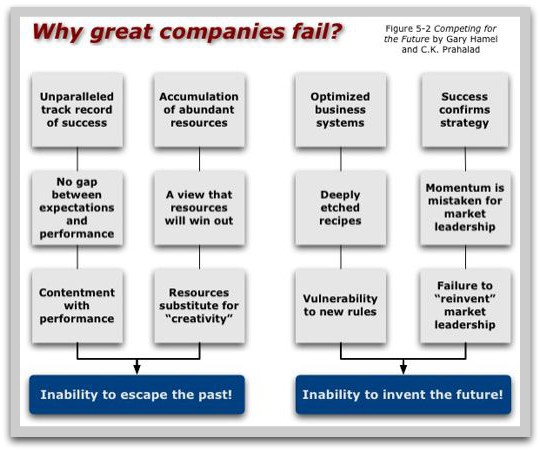
ACTION POINT:
Develop a system of performance measures that will lead to maximizing the total wealth-producing capacity of your organization.
Include both short-term measures and long-term measures, as well as quantitative and qualitative measures.
Management: Tasks, Responsibilities, Practices
7 MAR — Creating a True Whole
Create a true whole greater than the sum of its parts.
A manager has the task of creating a true whole that is larger than the sum of its parts.
One analogy is the task of the conductor of a symphony orchestra, through whose effort, vision, and leadership individual instrumental parts become the living whole of a musical performance.
But the conductor has the composer’s score; he is only interpreter.
The manager is both composer and conductor.
The task of creating a genuine whole also requires that the manager, in every one of her acts, consider simultaneously the performance and results of the enterprise as a whole and the diverse activities needed to achieve synchronized performance.
It is here, perhaps, that the comparison with the orchestra conductor fits best.
A conductor must always hear both the whole orchestra and, say, the second oboe.
Similarly, a manager must always consider both the overall performance of the enterprise and, say, the market research activity needed.
By raising the performance of the whole, she creates scope and challenge for market research.
By improving the performance of market research, she makes possible better overall business results.
The manager must simultaneously ask two double-barreled questions:
“What better business performance is needed and what does this require of what activities?”
And “What better performances are the activities capable of and what improvement in business results will they make possible?”
Management: Tasks, Responsibilities, Practices
Connect to Peter Drucker Social Political Ecologist
2 JUN — A Successful Information-Based Organization
The system worked because it was designed to ensure that each of its members had the information he needed to do his job.
The best example of a large and successful information-based organization, and one without any middle management at all, was the British civil administration in India.
The British ran the Indian subcontinent for two hundred years, from the middle of the eighteenth century through World War II.
The Indian civil service never had more than one thousand members to administer the vast and densely populated subcontinent.
Most of the Britishers lived alone in isolated outposts with their nearest countryman a day or two of travel away, and for the first hundred years there was no telegraph or railroad.
The organization structure was totally flat.
Each district officer reported directly to the “COO,” the provincial political secretary.
And since there were nine provinces, each political secretary had at least one hundred people reporting directly to him.
Each month the district officer spent a whole day writing a full report to the political secretary in the provincial capital.
He discussed each of his principal tasks.
He put down in detail what he had expected would happen with respect to each of them, what actually did happen, and why, if there was a discrepancy, the two differed.
Then he wrote down what he expected would happen in the ensuing month with respect to each key task and what he was going to do about it, asked questions about policy, and commented on long-term opportunities, threats, and needs.
In turn, the political secretary wrote back a full comment.
3 JUN — The “Score” in Information-Based Organizations
All the specialists in the hospital share a common “score”: the care and cure of the sick.
What can we say about the requirements of the information-based organization?
Several hundred musicians and their CEO, the conductor, can play together because they all have the same score.
Similarly, all the specialists in the hospital share a common mission:
the care and cure of the sick.
The diagnosis is their “score”; it dictates specific action for the X-ray lab, the dietitian, the physical therapist, and the rest of the medical team.
Information-based organizations, in other words, require clear, simple, common objectives that translate into particular actions.
Because the “players” in an information-based organization are specialists, they cannot be told how to do their work.
There are probably few orchestra conductors who could coax even one note out of a French horn, let alone show the horn player how to do it.
But the conductor can focus the horn player’s skill and knowledge on the musicians’ joint performance.
And this focus is what the leaders of an information-based business must be able to achieve.
An information-based business must be structured around goals that clearly state management’s performance expectations for the enterprise and for each part and specialist and around organized feedback that compares results with these performance expectations so that every member can exercise self-control.
13 FEB — The Nature of Freedom
Freedom is never a release and always a responsibility.
Freedom is not fun.
It is not the same as individual happiness, nor is it security or peace or progress.
It is a responsible choice.
Freedom is not so much a right as a duty.
Real freedom is not freedom from something; that would be license.
It is freedom to choose between doing or not doing something, to act one way or another, to hold one belief or the opposite.
It is not “fun” but the heaviest burden laid on man:
to decide his own individual conduct as well as the conduct of society and to be responsible for both decisions.
“The Freedom of Industrial Man,”
The Virginia Quarterly Review
Connections:
 Time-life navigation overview Time-life navigation overview
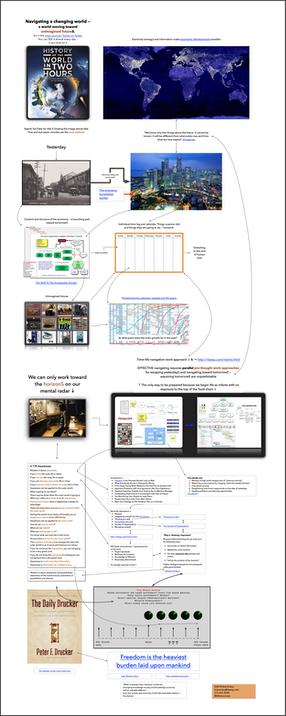
 Wisdom → awareness Wisdom → awareness
 The Josh Abrams story The Josh Abrams story
 Post-capitalist executive interview Post-capitalist executive interview
 The memo they don't want you to see — they want you to stay where you are (paying taxes and beholden to them) The memo they don't want you to see — they want you to stay where you are (paying taxes and beholden to them)
 The emerging knowledge society The emerging knowledge society
What is already clear, however, is that the emerging knowledge society and knowledge economy will be radically different from the society and economy of the late twentieth century.
 The danger to too much planning The danger to too much planning
Management as the alternative to tyranny is explored further down the page
26 JAN — A Social Ecologist
For me the tension between the need for continuity and the need for innovation and change was central to society and civilization.
I consider myself a “social ecologist,” concerned with man’s man-made environment the way the natural ecologist studies the biological environment.
The term “social ecology” is my own coinage.
But the discipline itself boasts an old and distinguished lineage.
Its greatest document is Alexis de Tocqueville’s Democracy in America.
But no one is as close to me in temperament, concepts, and approach as the mid-Victorian Englishman Walter Bagehot.
Living (as I have) in an age of great social change, Bagehot first saw the emergence of new institutions:
civil service and cabinet government, as cores of a functioning democracy, and
banking as the center of a functioning economy.
A hundred years after Bagehot, I was first to identify management as the new social institution of the emerging society of organizations and, a little later, to spot the emergence of knowledge as THE new central resource, and knowledge workers as the new ruling class of a society that is not only “post-industrial” but post-socialist and, increasingly, post-capitalist.
As it had been for Bagehot, for me too the tension between the need for continuity and the need for innovation and change was central to society and civilization.
Thus, I know what Bagehot meant when he said that he saw himself sometimes as a liberal Conservative and sometimes as a conservative Liberal but never as a “conservative Conservative” or a “liberal Liberal.”
ACTION POINT: Are you and your organization change agents? What steps can you take to both change and balance change with stability?
The Ecological Vision
27 MAY — Management: A Practice
The test of any policy in management … is not whether the answer is right or wrong, but whether it works.
The GM executives believed that they had discovered principles and that those principles were absolutes, like laws of nature.
I, by contrast, have always held that principles of this kind, being man-made, are at best heuristic.
This has been the one point on which my approach to management has always differed from that of the writers or theoreticians on the subject—and the reason, perhaps, that I have never been quite respectable in the eyes of academia.
I do believe that there are basic values, especially human ones.
But I do not believe that there is “one correct answer.”
There are answers that have a high probability of being the wrong ones—at least to the point where one does not even try them unless all else has failed.
But the test of any policy in management or in any other social discipline is not whether the answer is right or wrong, but whether it works.
Management, I have always believed, is not a branch of theology but, at bottom, a clinical discipline.
The test, as in the practice of medicine, is not whether the treatment is “scientific” but whether the patient recovers.
Concept of the Corporation
25 SEP — Controls Should Focus on Results
What today’s organization needs are synthetic sense organs for the outside.
Every social institution exists to contribute to society, economy, and individual.
In consequence results exist only on the outside—in economy, in society, and with the customer.
It is the customer only who creates a profit.
Everything inside a business creates only costs, is only a “cost center.”
But results are entrepreneurial.
Yet we do not have adequate, let alone reliable, information regarding the “outside.”
The century of patient analysis of managerial, inside phenomena, events and data, the century of patient, skillful work on the individual operations and tasks within the business, has no counterpart with respect to the entrepreneurial job.
We can easily record and therefore quantify efficiency, that is, efforts.
It is of little value to have the most efficient engineering department if it designs the wrong product.
And it mattered little, I daresay, during the period of IBM’s great expansion in the fifties and sixties how “efficient” its operations were; its basic entrepreneurial idea was the right, the effective one.
The outside, the area of results, is much less accessible than the inside.
The central problem of executives in the large organization is their insulation from the outside.
What today’s organization therefore needs are synthetic sense organs for the outside.
If modern controls are to make a contribution, it would be, above all, here.
Management: Tasks, Responsibilities, Practices
2 JAN — Identifying the Future
The important thing is to identify the “future that has already happened.”
Futurists always measure their batting average by counting how many things they have predicted that have come true.
They never count how many important things come true that they did not predict.
Everything a forecaster predicts may come to pass.
SO VERY DIFFERENT
Yet, he may not have seen the most meaningful of the emergent realities or, worse still, may not have paid attention to them.
There is no way to avoid this irrelevancy in forecasting, for the important and distinctive are always the result of changes in values, perception, and goals, that is, in things that one can divine but not forecast.
But the most important work of the executive is to identify the changes that have already happened.
The important challenge in society, economics, politics, is to exploit the changes that have already occurred and to use them as opportunities.
The important thing is to identify the “future that has already happened”—and to develop a methodology for perceiving and analyzing these changes.
A good deal of this methodology is incorporated in my 1985 book Innovation and Entrepreneurship, which shows how one systematically looks to the changes in society, in demographics, in meaning, in science and technology, as opportunities to make the future.
Innovation in the existing organization requires special effort and more
The Ecological Vision
The Age of Discontinuity
10 MAR — Searching for Change
A change is something people do; a fad is something people talk about.
Entrepreneurs see change as the norm and as healthy.
Usually they do not bring about the change themselves.
But — and this defines the entrepreneur and entrepreneurship — the entrepreneur always searches for change, responds to it, and exploits it as an opportunity.
Look at every change, look out every window.
And ask:
"Could this be an opportunity?"
"Is this new thing a genuine change or simply a fad?"
The difference is very simple: A change is something people do, and a fad is something people talk about.
An enormous amount of talk is a fad.
You must also ask yourself if these transitions, these changes, are an opportunity or a threat.
If you start out by looking at change as threat, you will never innovate.
Don't dismiss something because this is not what you had planned.
The unexpected is often the best source of innovation.
Managing in the Next Society
12 MAY — The Manufacturing Paradox
How do you get far more output with far fewer workers?
The most believable forecast for 2020 suggests that manufacturing output in the developed countries will at least double, while manufacturing employment will shrink to 10 to 12 percent of the total workforce. What has changed manufacturing, and sharply pushed up productivity, are new concepts, such as “lean manufacturing.”:
Information and automation are less important than new theories of manufacturing, which are an advance comparable to the arrival of mass production eighty years ago.
The decline in manufacturing as a creator of wealth and jobs will inevitably bring about a new protectionism, once again echoing what happened earlier in agriculture.
The fewer farm voters there are, the more important the “farm vote” has become.
As numbers have shrunk, farmers have become a unified special-interest group that carries disproportionate clout in all rich countries.
Managing in the Next Society
9 JAN — The New Corporation’s Persona
In the Next Society’s corporation, top management will be the company.
Everything else can be outsourced.
Increasingly, in the Next Society’s corporation, top management will, in fact, be the company.
This top management’s responsibilities will cover the entire organization’s
 direction, planning, strategy, values, and principles; direction, planning, strategy, values, and principles;
 its structure and relationships between its various members; its structure and relationships between its various members;
 its alliances, partnerships, and joint ventures; and its alliances, partnerships, and joint ventures; and
 its research, design, and innovation. its research, design, and innovation.
Establishing a new corporate persona calls for a change in the corporation’s values.
And that may well be the most important task for top management.
In the half century after the Second World War, the business corporation has brilliantly proven itself as an economic organization, as a creator of wealth and jobs.
In the Next Society, the biggest challenge for the large company and especially for the multinational may be its social legitimacy—its values, its mission, its vision.
Everything else can be outsourced.
Managing in the Next Society
The Next Society (Corpedia Online Program)
17 JAN — Management: The Central Social Function
Noneconomic institutions need a yardstick that does for them what profitability does for business.
Nonbusiness institutions flock in increasing numbers to business management to learn from it how to manage themselves.
The hospital, the armed service, the Catholic diocese, the civil service—all want to go to school for business management.
This does not mean that business management can be transferred to other, nonbusiness institutions.
On the contrary, the first thing these institutions have to learn from business management is that management begins with the setting of objectives and that, therefore, noneconomic institutions, such as a university or a hospital, will also need very different management from that of a business.
But these institutions are right in seeing business management as the prototype.
Business, far from being exceptional, is simply the first of the species and the one we have studied the most intensively.
Noneconomic institutions need a yardstick that does for them what profitability does for the business.
“Profitability,” in other words, rather than being the “exception” and distinct from “human” or “social” needs, emerges, in the pluralist society of organizations, as the prototype of the measurement needed by every institution in order to be managed and manageable.
The Ecological Vision
10 FEB — Modern Organization Must Be a Destabilizer
Only a society in dynamic disequilibrium has stability and cohesion.
Society, community, and family are all conserving institutions.
They try to maintain stability and to prevent, or at least to slow, change.
And yet we also know that theories, values, and all the artifacts of human minds do age and rigidify, becoming obsolete, becoming afflictions.
Yet “revolutions” every generation, as was recommended by Thomas Jefferson, are not the solution.
We know that “revolution” is not achievement and the new dawn.
It results from senile decay, from the bankruptcy of ideas and institutions, from a failure of self-renewal.
The only way in which an institution—whether a government, a university, a business, a labor union, an army—can maintain continuity is by building systematic, organized innovation into its very structure.
Institutions, systems, policies, eventually outlive themselves, as do products, processes, and services.
They do it when they accomplish their objectives, and they do it when they fail to accomplish their objectives.
Innovation and entrepreneurship are thus needed in society as much as in the economy, in public service institutions as much as in business.
The modern organization must be a destabilizer; it must be organized for innovation.
Managing in a Time of Great Change
The Ecological Vision
Innovation and Entrepreneurship
2 MAR — Test of Innovation
Measure innovations by what they contribute to market and customer.
The test of an innovation is whether it creates value.
Innovation means the creation of new value and new satisfaction for the customer.
A novelty only creates amusement.
Yet, again and again, managements decide to innovate for no other reason than that they are bored with doing the same thing or making the same product day in and day out.
The test of an innovation, as well as the test of “quality,” is not “Do we like it?”
It is “Do customers want it and will they pay for it?”
Organizations measure innovations not by their scientific or technological importance but by what they contribute to market and customer.
They consider social innovation to be as important as technological innovation.
Installment selling may have had a greater impact on economics and markets than most of the great scientific advances in this century.
The Frontiers of Management
Management Challenges for the 21st Century
13 JUL — Unexpected Success
It takes an effort to perceive unexpected success as one’s own best opportunity.
It is precisely because the unexpected jolts us out of our preconceived notions, our assumptions, our certainties, that it is such a fertile source of innovation.
In no other area are innovative opportunities less risky and their pursuit less arduous.
Yet the unexpected success is almost totally neglected; worse, managements tend actively to reject it.
One reason why it is difficult for management to accept unexpected success is that all of us tend to believe that anything that has lasted a fair amount of time must be “normal” and go on “forever.”
This explains why one of the major U.S. steel companies, around 1970, rejected the “mini-mill.”
Management knew that its steelworks were rapidly becoming obsolete and would need billions of dollars of investment to be modernized.
A new, smaller “mini-mill” was the solution.
Almost by accident, such a “mini-mill” was acquired.
It soon began to grow rapidly and to generate cash and profits.
Some of the younger people within the steel company proposed that available investment funds be used to acquire additional “mini-mills” and to build new ones.
Top management indignantly vetoed the proposal.
“The integrated steelmaking process is the only right one,” top management argued.
“Everything else is cheating—a fad, unhealthy, and unlikely to endure.”
Needless to say, thirty years later the only parts of the steel industry in America that were still healthy, growing, and reasonably prosperous were “mini-mills.”
Innovation and Entrepreneurship
4 JUL — Communicate and Test Assumptions
The theory of the business is a discipline.
The theory of the business must be known and understood throughout the organization.
This is easy in an organization’s early days.
But as it becomes successful, an organization tends increasingly to take its theory for granted, becoming less and less conscious of it.
Then the organization becomes sloppy.
It begins to cut corners.
It begins to pursue what is expedient rather than what is right.
It stops thinking.
It stops questioning.
It remembers the answers but has forgotten the questions.
The theory of the business becomes “culture.”
But culture is no substitute for discipline, and the theory of the business is a discipline.
The theory of the business has to be tested constantly.
It is not graven on tablets of stone.
It is a hypothesis.
And it is a hypothesis about things that are in constant flux—society, markets, customers, technology.
And so, built into the theory of the business must be the ability to change itself.
Some theories are so powerful that they last for a long time.
Eventually every theory becomes obsolete and then invalid.
It happened to the GMs and the AT&Ts.
It happened to IBM.
It is also happening to the rapidly unraveling Japanese keiretsu.
Managing in a Time of Great Change
26 MAR — Management of the Multinational
The multinationals of 2025 are likely to be held together and controlled by strategy.
Statistically, multinational companies play much the same part in the world economy today as they did in 1913.
But they have become very different animals.
Multinationals in 1913 were domestic firms with subsidiaries abroad, each of them self-contained, in charge of a politically defined territory, and highly autonomous.
Multinationals now tend to be organized globally along product or service lines.
But like the multinationals of 1913, they are held together and controlled by ownership.
By contrast, the multinationals of 2025 are likely to be held together and controlled by strategy.
There will still be ownership, of course.
But alliances, joint ventures, minority stakes, know-how agreements and contracts, will increasingly be the building blocks of a confederation.
This kind of organization will need a new kind of top management.
In most countries, and even in a good many large and complex companies, top management is still seen as an extension of operating management.
Tomorrow’s top management, however, is likely to be a distinct and separate organ: it will stand for the company.
Managing in the Next Society
10 JAN — Management as the Alternative to Tyranny
The alternative to autonomous institutions that function and perform is not freedom. It is totalitarian tyranny.
If the institutions of our pluralist society of institutions do not perform in responsible autonomy, we will not have individualism and a society in which there is a chance for people to fulfill themselves.
We will, instead, impose on ourselves complete regimentation in which no one will be allowed autonomy.
We will have Stalinism rather than participatory democracy, let alone the joyful spontaneity of doing one’s own thing.
Tyranny is the only alternative to strong, performing autonomous institutions.
Tyranny substitutes one absolute boss for the pluralism of competing institutions.
It substitutes terror for responsibility.
It does indeed do away with the institutions, but only by submerging all of them in the one all embracing bureaucracy of the apparat.
It does produce goods and services, though only fitfully, wastefully, at a low level, and at an enormous cost in suffering, humiliation, and frustration.
To make our institutions perform responsibly, autonomously, and on a high level of achievement is thus the only safeguard of freedom and dignity in the pluralist society of institutions.
Performing, responsible management is the alternative to tyranny and our only protection against it.
Management: Tasks, Responsibilities, Practices
29 OCT — Converting Good Intentions into Results
“It’s much easier to sell the Brooklyn Bridge than to give it away.”
The nonprofit institution is not merely delivering a service.
It wants the end user to be not a user but a doer.
It uses a service to bring about a change in human beings.
It attempts to become a part of the recipient rather than merely a supplier.
Nonprofit institutions used to think they didn’t need marketing.
But, as a famous old saying by a great nineteenth-century con man has it, “It’s much easier to sell the Brooklyn Bridge than to give it away.”
Nobody trusts you if you offer something for free.
You need to market even the most beneficial service.
But the marketing you do in the nonprofit sector is quite different from selling.
It’s more a matter of looking at your service from the recipient’s point of view.
You have to know what to sell, to whom to sell, and when to sell.
ACTION POINT:
The mission of the Salvation Army is to make citizens out of the rejected.
How does that service look from the recipient’s point of view?
How should the Salvation Army market that service?
Managing the Non-Profit Organization
25 AUG — Three Case Studies on Innovation Strategy
Three pharmaceutical companies—Able, Baker, and Charlie—are among the most successful pharmaceutical businesses in the world.
Able and Baker are very large.
Charlie is medium-sized, but growing fast.
All three companies spend about the same percentage of their revenues on research.
There the similarity ends.
Each of them approaches research quite differently.
Able Company: Research Strategy
Able’s aim is to gain early leadership in a major area, acquire dominance in it, and then maintain this leadership position.
Able Company spends a great deal of research money on one carefully selected area at a time.
It picks this area when pure research in the universities first indicates a genuine breakthrough.
Then, long before commercial products are available, it hires the very best people in the field, and puts them to work.
Outside of these areas, however, the company spends no research money and is perfectly willing not to be a factor at all.
The company takes big positions in big fields at a very early stage, at great risk, but also at great reward.
ACTION POINT: Able Company is pursuing the _____ entrepreneurial strategy (see August 16) and the _______ window of opportunity (see July 12).
Management Cases
26 AUG — Baker Company: Research Strategy
Baker’s aim is to come up with a small number of drugs in each field that are clearly superior and offer significant advances to medical practice.
The strategy of Baker Company is completely different.
Its research lab [Search for “research lab” on this page], perhaps the most famous in the pharmaceutical industry, works in an enormous number of fields.
It does not, however, enter a field until the basic scientific theoretical work has been done.
Then it goes to work.
Of every ten products that come out of its own laboratory, the company itself markets no more than two or three.
When it becomes reasonably clear that an effective drug will result from a line of research, the company carefully scrutinizes the product and, indeed, the entire field.
First, is the new product likely to be medically so superior as to become the new “standard”?
Second, is it likely to have major impact throughout the field of health care and medical practice rather than be confined to one specialty area, even a large one?
And finally, is it likely to remain the “standard” for a good many years, rather than to be overtaken by competitive products? ¶ ¶ ¶
If the answer to any of these three questions is “No,” the company will license or sell the development, rather than convert it into a product of its own.
This has been highly profitable in two ways.
- It has generated licensing income almost equal to the profits the company makes on the drugs it makes and sells under its own name.
- And it has assured that each of the company’s products is considered the “leader” by the medical profession.
ACTION POINT: Test your organization’s innovative strategy against that of Baker Company.
Management Cases
27 AUG — Charlie Company: Research Strategy
Charlie Company does no research. It looks for areas where a fairly simple development can give it a near-monopoly position in a small but important area.
Charlie Company does no research.
All it does is develop.
It will not tackle any of the products Able or Baker companies consider attractive.
It looks for areas in medical and surgical practice where existing products are not doing a good job, and where a fairly simple change can greatly improve the doctor’s or surgeon’s performance.
And it looks for fields that are so small that once there is a truly superior product, there is no incentive for anyone else to go in and compete. ¶ ¶ ¶
Its first product was a simple enzyme—actually known for forty years to make cataract operations virtually bloodless and greatly ease the eye surgeon’s job.
All the work that had to be done was to find a way to extend the shelf life of the enzyme.
The next product was a very simple ointment to put on the umbilical cord of infants to prevent infection and speed up healing.
It has become standard in every maternity hospital throughout the world.
The company later brought out a product to replace the toxic solution with which newborn babies used to be washed to prevent infection again, primarily a matter of compounding rather than discovering.
In each area, the world market is so limited—maybe to $20 million—that a single supplier, provided it offers a truly superior product, can occupy a near-monopoly position with a minimum of competition and practically no pressure on price.
ACTION POINT: Test your organization’s innovative strategy against that of Charlie Company.
Management Cases
4 FEB — Knowledge and Technology
The new technology embraces and feeds off the entire array of human knowledges.
The search for knowledge, as well as the teaching thereof, has traditionally been dissociated from application.
Both have been organized by subject, that is, according to what appeared to be the logic of knowledge itself.
The faculties and departments of the university, its degrees, its specializations, indeed the entire organization of higher learning, have been subject-focused.
They have been, to use the language of the experts on organization, based upon “product,” rather than on “market” or “end use.”
Now we are increasingly organizing knowledge and the search for it around areas of application rather than around the subject areas of disciplines.
Interdisciplinary work has grown everywhere.
This is a symptom of the shift in the meaning of knowledge from an end in itself to a resource, that is, a means to some result.
Knowledge as the central energy of a modern society exists altogether in application and when it is put to work.
Work, however, cannot be defined in terms of the disciplines.
End results are interdisciplinary of necessity.
… but not knowledge as it is presented in the education system
9 AUG — Research Laboratory: Obsolete?
Technologies crisscross industries and travel incredibly fast.
What accounts for the decline in the number of major corporate research labs?
The company-owned research laboratory was one of the nineteenth century’s most successful inventions.
Now many research directors, as well as high-tech industrialists, tend to believe that such labs are becoming obsolete.
Why?
Technologies crisscross industries and travel incredibly fast, making few of them unique anymore.
And increasingly, the knowledge needed in a given industry comes out of some totally different technology with which, very often, the people in the industry are quite unfamiliar.
As a result the big research labs of the past are becoming obsolete.
The research laboratory of the big telephone companies, the famous Bell Laboratories of the U.S., was for many decades the source of all major innovations in the telephone industry.
But no one in that industry worked on fiberglass cables or had ever heard of them.
They were developed by a glass company, Corning.
Yet they have revolutionized communications worldwide.
20 JUL — New Knowledge
In the theory and practice of innovation and entrepreneurship, the bright-idea innovation belongs in the appendix.
New knowledge is not the most reliable or most predictable source of successful innovations.
For all the visibility, glamour, and importance of science-based innovation, it is actually the least reliable and least predictable one.
Knowledge-based innovation has the longest lead-time of any innovation.
First, there is a long time span between the emergence of new knowledge, and it’s becoming applicable to technology.
And then there is another long period before the new technology turns into products, processes, or services in the marketplace.
The introduction of innovation creates excitement and attracts a host of competitors, meaning that innovators have to be right the first time.
They are unlikely to get a second chance.
Here, even successful innovators almost immediately have far more company than they want and must prepare themselves to weather the storm that lies ahead.
For example, Apple Computer invented the personal computer.
IBM was able to wrest market leadership from Apple through creative imitation.
Apple failed to maintain its leadership position and became a niche player because it failed to predict and respond to the competition it would face.
In the theory and practice of innovation and entrepreneurship, the bright-idea innovation belongs in the appendix.
But it should be appreciated and rewarded.
It represents qualities that society needs: initiative, ambition, and ingenuity.

Work life foundationS ↓ — brainroadS — for the roadS ahead ↓
9 SEP — Take Responsibility for Your Career
In a changing world there is both a need and opportunity
to continuously explore for evolving “social positions and roles” (not jobs) —
especially when situations are discontinuous and highly competitive
The multiple “sidebars” ↓ that follow offer worldview landscape awareness.
A restaurant menu allows customers to select the items that fit their current appetite —
steak, fries, pie. It is very hard to choose if the alternatives aren't familiar or visible.
It can be hard to choose intelligently if the menu is in an unfamiliar language.
The following sidebars concepts are items on a time usage menu.
Basic reality check ↓
The composition and operation of
our “mental radar” ↓
determines our futureS …
especially in a world moving
relentlessly
toward unimagined futureS
— that means “tomorrow” is not going to be like “today”
(which is really “yesterday” because “today”
is the product of “yesterday”)
When we are involved in doing something
we are nearly blind to the realities unfolding around us ↓
and … then it’s too late …
The future is between our ears ↑ ↓
Awareness !!!
Danger → the patterning system of the human brain —
competing patterns ↑ ↑ ↓ ↓ are essential for survival
Exploring time usage alternatives ↓
is attention-directing work
and it is essential
in a world moving toward unimagined futureS
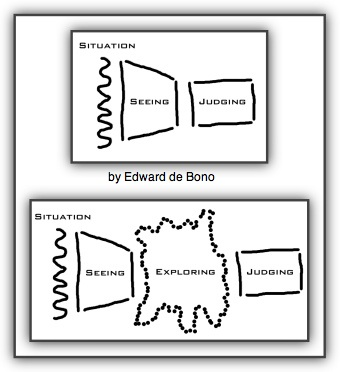
Exploring ↑ is attention-directing ↓ work
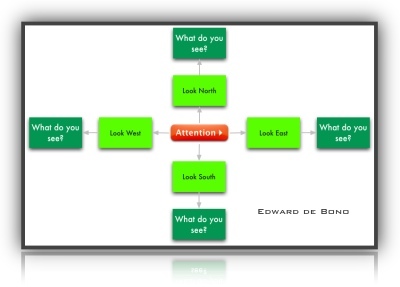
Time is the limiting factor in the process
we call “accomplishment” continue
“One can … ever be sure
what the knowledge worker thinks—and yet
THINKING !!! is her/his specific work;
it is his/her “doing.”” ↓
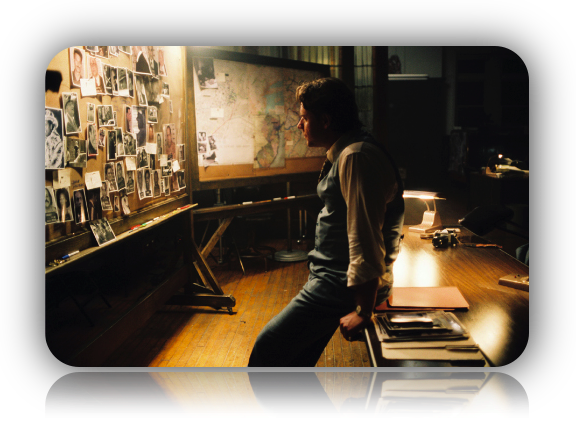
Time usage decisions ↑
for/in a world moving toward unimagined futureS ↓
It would be a good idea to read completely through the
following group of days (until you come to an obvious break)
before clicking too many links
About Peter Drucker (very-top of the food-chain)
an unparalleled grasp of the big picture …
An original thinker and not just another academic or theorist
(you may find yourself competing with his many followers)
Freedom: the heaviest burden … ::: Awareness
↑ both explore major time usage concepts
Everything here ↑ ↓ resides in time — a world relentlessly moving toward unimagined futureS
Unimagined to YOU and unimagined to EVERYONE else — except
the future that has already happened
Awareness ↑ ↓
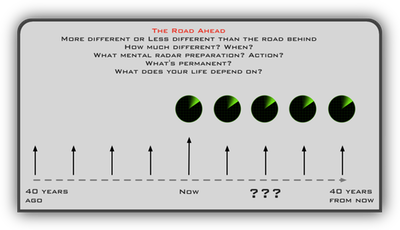
A change in the human condition ↑ begins
↑ Click the multiple “Jump to the next major idea?” links ↑ to speed read
Post-Capitalist Society ↑ ↓
Use the calm before the storm ↑ to your advantage ↓
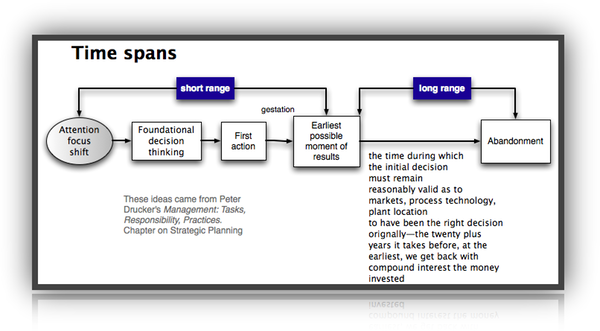
Horizons to consider working toward:
Foundations for future directed decisions ↓
Just reading is not enough … harvesting and action thinking are needed (further down the page).
 Information and thinking Information and thinking
 Concepts and action Concepts and action
The next entry — 1 Jun → Managing Oneself — provides a skeleton or framework on which to place, arrange, and build other ideas, concepts, and situations — timescapes and surrounding environments (worldviews ↓)

Mentally SEE → living through a world moving toward unimagined futures — a quick scroll down the first part of the page is all that is needed to get the basic idea (worldview) ↓
What Everybody Knows Is Frequently Wrong ::: If You Keep Doing What Worked in the Past You’re Going to Fail ::: Approach Problems with Your Ignorance—Not Your Experience ::: Develop Expertise Outside Your Field to Be an Effective Manager ::: Outstanding Performance Is Inconsistent with Fear of Failure ::: You Must Know Your People to Lead Them ::: People Have No Limits, Even After Failure ::: Base Your Strategy on the Situation, Not on a Formula — A Class With Drucker: The Lost Lessons of the World's Greatest Management Teacher
Mentally SEE → the content and structure of the economy then try to imagine the invisible and evolving environment in which the knowledge specialist must exist — a quick scroll down the page is all that is needed at this point to get the basic idea (worldview and a thinking landscape → ← timescape)
Driving past an office complex you can see the parking lots, buildings, people in their offices, but you can’t see what the organization is trying to do or ultimately do. Plus you can’t see each individual’s contribution — further down the page — to what the organization is aiming to do or the reaction of their outside customers ↑.
Allocating your life — nobody is going to do it for you
Dangerous liaisons (worldview)
Calendarization → working something out in time and putting the next action step on or in your calendar with an adequate, fail-safe reminder. What will you calendarize from these brainroads? continue
The individual in entrepreneurial society (worldview)
How can the individual survive? (worldview)
Every single social and global issue of our day — at a point in time — is a business opportunity in disguise ↓ (worldviews)
How To Guarantee Non-Performance
Social Needs and Business Opportunities
Social Innovation — Management’s New Dimension
Citizenship Through the Social Sector
Ten Principles for Life II
Drucker’s life as a knowledge worker
What do you want to be remembered for? continue
Executive realities #ee continue
The realities of the executive’s situation both demand effectiveness from him and make effectiveness exceedingly difficult to achieve.
Indeed, unless executives work at becoming effective, the realities of their situation will push them into futility.
The executive’s time tends to belong to everybody else
Executives are forced to keep on “operating” unless they take positive action
Being within an “organization” pushes the executive toward ineffectiveness
Finally, the executive is “within” an organization
From analysis to perception the new worldview
Luther, Machiavelli, and the Salmon (worldview)
Long years of profound change (worldview)
Radical change in structure for the organizations of tomorrow (worldview)
Primacy of knowledge … Doing business in a Lego world … A new solution space (worldview)
Technology (a broader mental landscape than “things”)
Unless we can learn how to increase the productivity of knowledge workers and service workers, and increase it fast, the developed countries will face economic stagnation and severe social tension. continue (worldview)
The Vanishing East (a timescape and worldview)
The manager and the moron (knowledge, technology, competition, time-usage … evolving worldviews ← thinking entry point)
Larger view ↓
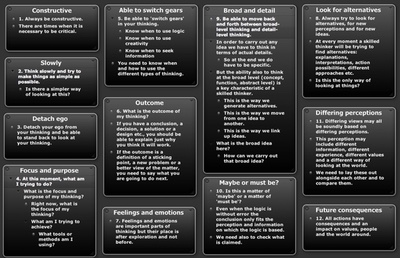
Text ↑ + new thinking ::: Practical Thinking
Jumping back in time — Landmarks of Tomorrow (a timescape and worldview)
Living in an Age of Overlap
Post-Capitalist Society
Every few hundred years in Western history there occurs a sharp transformation. We cross what in an earlier book, I called a “divide.” Within a few short decades, society rearranges itself—its worldview; its basic values; its social and political structure; its arts; its key institutions continue
… Indeed, it is one of the fundamental changes that there no longer is a “Western” history or, in fact, a “Western” civilization. There is only world history and world civilization—but both are “Westernized.”
Post Capitalist Society and Post Capitalist Polity continue … The Shift To The Knowledge Society … Outflanking the Nation-State … The Third World … Society, Polity, Knowledge … From Capitalism to Knowledge Society
The management revolution (worldview)
The society of organizations continue … Is Labor Still an Asset? … How Much Labor Is Needed—and What Kind? … The Productivity of the New Work Forces … From Command to Information to Responsibility
Transnationalism, Regionalism, and Tribalism (worldview)
But in the last decades—beginning perhaps in the 1970s—the nation-state has begun to come apart. It has already been outflanked in crucial areas where “sovereignty” has lost all meaning.
Increasingly, the new challenges facing every government are challenges that simply cannot be dealt with by national or even international action. They require transnational agencies, which have a “sovereignty” of their own.
Increasingly, regionalism is also sidelining the nation-state. And internally, the nation-state is being undermined by tribalism.
Money going transnational outflanks the nation-state by nullifying national economic policy. Information going transnational outflanks the nation-state by undermining (in fact, destroying) the identification of “national” with “cultural” identity.
Internationalism and regionalism challenge the sovereign nation-state from the outside.
Tribalism undermines it from within. It saps the nation-state’s integrating power. In fact, it threatens to replace nation with tribe.
The more transnational the world becomes, the more tribal it will also be. This undermines the very foundations of the nation-state. In fact, it ceases to be a “nation-state,” and becomes a “state” plain and simple, an administrative rather than a political unit.
Internationalism, regionalism, and tribalism between them are rapidly creating a new polity, a new and complex political structure, without precedent.
Citizenship through the Social Sector continue
“The terms knowledge industries, knowledge work, and knowledge worker are only forty years old … Now everyone uses them, but as yet hardly anyone understands their implications for human values and human behavior, for managing people and making them productive, for economics and for politics.” continue (worldview)
“And then there is the new “basic resource” information. It differs radically from all other commodities in that it does not stand under the scarcity theorem. On the contrary, it stands under an abundance theorem.” continue (worldview)
…“ every business must become globally competitive, even if it manufactures or sells only within a local or regional market. The competition is not local anymore—in fact, it knows no boundaries. Every company has to become transnational in the way it is run … ” continue (worldview)
All Daily Drucker sample days — further up the page ::: Complete Daily Drucker contents list (worldview)
↓ worldview ↑

Intelligence and behavior ↑ ↓ — Niccolò Machiavelli ↑ ↓
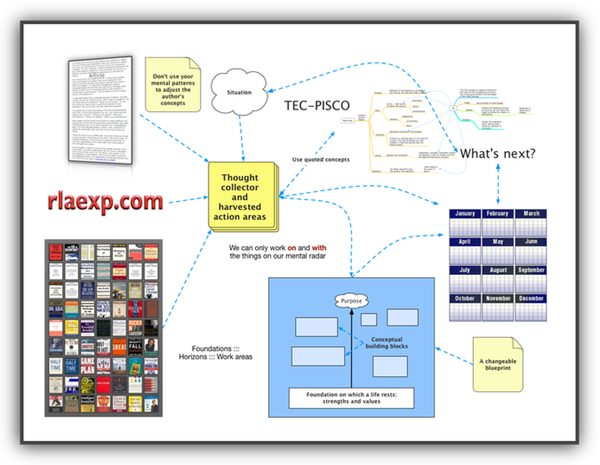
Larger view ↑
Thought collector and harvested action items ↑
“Concentration—that is, the courage to impose on time and events
[one’s] own decision as to what really matters and comes first—is
the executive’s only hope of becoming the master
of time and events instead of their whipping boy.” PFD
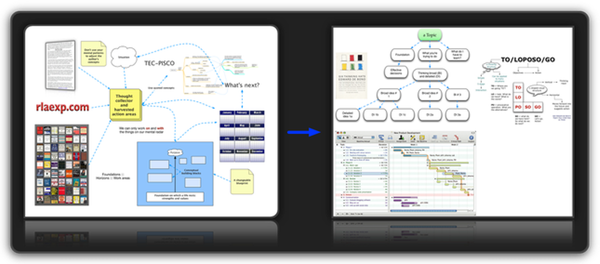
Larger view ↑
Six Thinking Hats ↓ ::: Teach Yourself to Think ↓ ::: Why?
Thinking canvases are needed
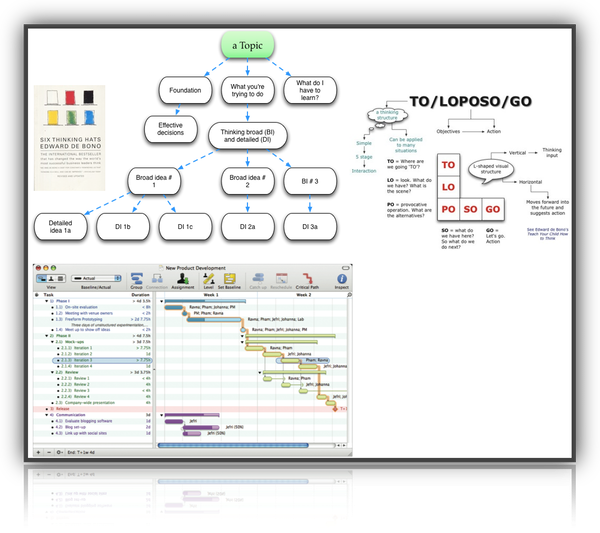
Larger view ↑
main brainroad continues ↓
The stepladder is gone, and there’s not even the implied structure of an industry’s rope ladder. It’s more like vines, and you bring your own machete.
↑ In much greater depth ↓
If a young man in a gray flannel suit represented the life long corporate type, what’s today’s image?
Taking individual responsibility and not depending on any particular company.
Larger view ↓
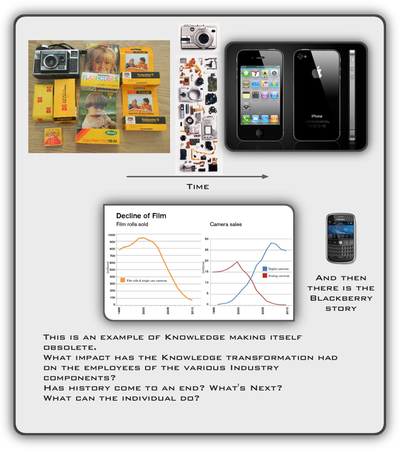
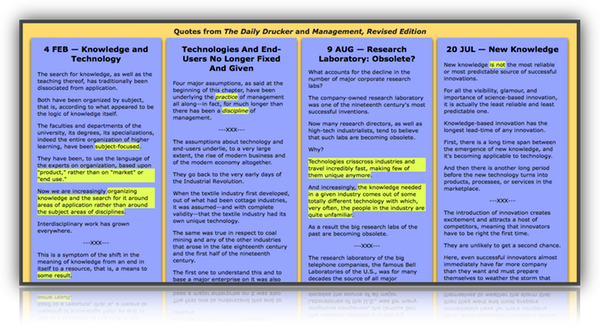
More on the modern chaos ↑
Equally important is managing your own career(s).
The Individual In Entrepreneurial Society
You don’t know what you’ll be doing next, or whether you’ll work in a private office or one big amphitheater or even out of your home.
You have to take responsibility for knowing yourself, so you can find the right jobs as you develop and as your family becomes a factor in your values and choices.
Remarkably few Americans are prepared to select jobs for themselves.
When you ask, “Do you know what you are good at?
Do you know your limitations?” they look you in the eye with a blank stare.
Or they often respond in terms of subject knowledge, which is the wrong answer.
When they prepare their résumés, they try to list positions like steps up a ladder.
It is time to give up thinking of jobs or career paths as we once did and think in terms of taking on one assignment after another — further down the page.

We have to leap right over the search for objective criteria and get into the subjective—what I call competencies.
Ten Principles for Life II
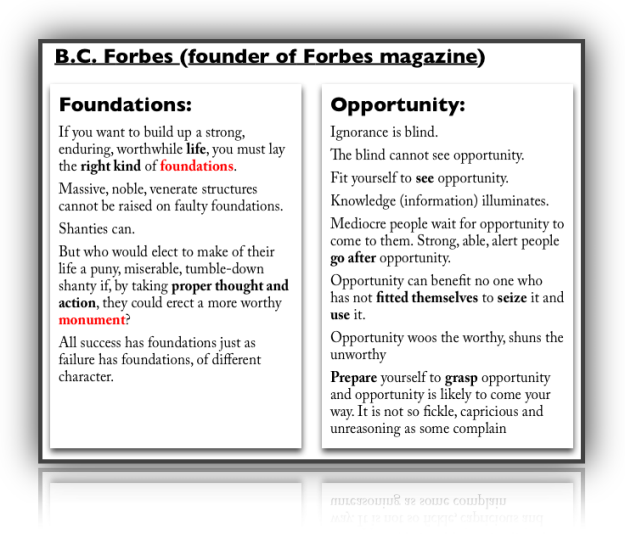
Awareness ↑ ↓
1 JUN — Managing Oneself #mo
Knowledge workers must take responsibility for managing themselves.
All of this takes place within a changing world — a world moving toward unimagined futures
It is important to see knowledge specialty and knowledge work as different from university courses — no matter how advanced — and as necessary elements of a functioning society. The right kind of education is required — an introduction.
Knowledge workers are likely to outlive their employing organization.
Executive realities
Their average working life is likely to be fifty years.
But the average life expectancy of a successful business is only thirty years — and shrinking.
Increasingly, therefore, knowledge workers will outlive any one employer, and will have to be prepared for more than one job.
And this means most knowledge workers will have to MANAGE THEMSELVES.
They have to place themselves ↓ where they can make the greatest contribution; they will have to learn to develop themselves.
They will have to learn how and when to change what they do, how they do it, and when they do it.
Josh Abrams stages + starting points
The key to managing oneself is to know:
Who am I?
What are my strengths?
How do I work to achieve results?
What are my values?
Where do I belong? ↑ ↓
Your conclusions ↑ depend on what’s between your ears ↑ → Going solo and placing oneself
Where do I not belong?
Finally, a crucial step in successfully managing oneself is FEEDBACK ANALYSIS.
Record what you expect the results to be of every key action or key decision you take, and then compare ACTUAL RESULTS nine months or a year later to your expectations. continue
Equally important, knowing the answer to these questions enables a person to say to an opportunity, an offer, or an assignment, “Yes, I will do that.
But this is the way I should be doing it.
This is the way it should be structured.
This is the way the relationships should be.
These are the kind of results you should expect from me, and in this time frame, because this is who I am.”
Successful careers are not planned
They develop when people are prepared for opportunities because they know their strengths, their method of work, and their values.
Knowing where one belongs can transform an ordinary person—hardworking and competent but otherwise mediocre—into an outstanding performer.
You might find it helpful to create a mind map for each of these areas of thinking
Full size ↓
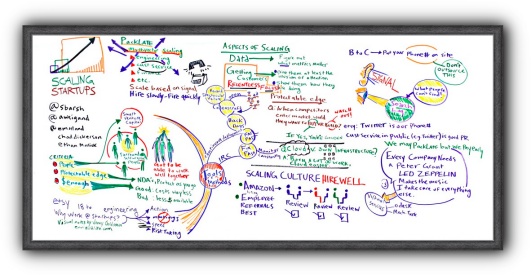
“Amazingly few people know how they get things done.
Indeed, most of us do not even know that different people work and perform differently.
Too many people work in ways that are not their ways, and that almost guarantees nonperformance.
For knowledge workers, How do I perform? may be an even more important question than What are my strengths?
Like one’s strengths, how one performs is unique.
It is a matter of personality.
Whether personality be a matter of nature or nurture, it surely is formed long before a person goes to work.
And how a person performs is a given, just as what a person is good at or not good at is a given.
A person’s way of performing can be slightly modified, but it is unlikely to be completely changed—and certainly not easily.
Just as people achieve results by doing what they are good at, they also achieve results by working in ways that they best perform.
A few common personality traits usually determine how a person performs.
The first thing to know is whether you are a reader or a listener.
Far too few people even know that there are readers and listeners and that people are rarely both.
Even fewer know which of the two they themselves are.”
What makes an effective executive? ::: What executives should remember ::: Drucker’s narrower time books
18 SEP — Managing Oneself: Revolution in Society
Managing oneself is based on these realities: Workers are likely to outlive organizations, and the knowledge worker has mobility.
Managing oneself is a REVOLUTION in human affairs.
It requires new and unprecedented things from the individual, and especially from the knowledge worker.
For, in effect, it demands that each knowledge worker think and behave as a chief executive officer.
It also requires an almost 180-degree change in the knowledge workers’ thoughts and actions from what most of us still take for granted as the way to think and the way to act.
The shift from manual workers who do as they are being told—either by the task or by the boss—to knowledge workers who have to manage themselves profoundly challenges social structure.
For every existing society, even the most “individualist” one, takes two things for granted, if only subconsciously: Organizations outlive workers, and most people stay put.
Managing oneself is based on the very opposite realities.
In the United States MOBILITY is accepted.
Search this page and this page for the word “mobility”
But even in the United States, workers outliving organizations—and with it the need to be prepared for a second and different half of one’s life—is a revolution for which practically no one is prepared.
Ten Principles for Life II
Nor is any existing institution, for example, the present retirement system.
Management Challenges for the 21st Century
The future of society
11 JUN — Place Yourself in the Right Organization — Where do I belong?
Where do I belong as a person?
To develop yourself, you have to be doing the right work in the right kind of organization.
The basic question is:
“Where do I belong as a person?”
This requires understanding what kind of work environment you need to do your best:
A big organization or a small one?
Working with people or alone?
In situations of uncertainty or not?
Under pressures of deadlines?
If the thoughtful answer to the question “Where do I belong?” is that you don’t belong where you currently work, the next question is why?
Is it because you can’t accept the values of the organization?
Is the organization corrupt?
That will certainly damage you, because you become cynical and contemptuous of yourself if you find yourself in a situation where the values are incompatible with your own.
Or you might find yourself working for a boss who corrupts because he’s a politician or because he’s concerned only with his career.
Or—most tricky of all—a boss whom you admire fails in the crucial duty of a boss:
to support, foster, and promote capable subordinates.
The right decision is to quit if you are in the wrong place, if it is basically corrupt, or if your performance is not being recognized.
ACTION POINT:
Are you in the right organization?
Why or why not?
If not, should you quit?
Managing the Non-Profit Organization
5 SEP — Focus on #Contribution
The question “What should I contribute?” gives freedom because it gives responsibility.
All of this takes place within a changing world — a world moving toward unimagined futures
The great majority of executives tend to focus downward.
They are occupied with efforts rather than with results.
They worry over what the organization and their superiors “owe” them and should do for them.
And they are conscious above all of the authority they “should have.”
As a result, they render themselves ineffectual.
The effective executive focuses on #contribution.
He looks up from his work and outward toward goals.
He asks: “What can I contribute that will significantly affect the performance and the results of the institution I serve?”
His stress is on responsibility.
The focus on #contribution is the key to effectiveness: in a person’s own work—its content, its level, its standards, and its impacts; in his relations with others—his superiors, his associates, his subordinates; in his use of the tools of the executive such as meetings or reports.
The focus on #contribution turns the executive’s attention away from his own specialty, his own narrow skills, his own department, and toward the performance of the whole.
It turns his attention to the outside, the only place where there are results.
The Effective Executive
Management Challenges for the 21st Century
14 SEP — Managing Oneself: What to Contribute? #mo #contribution #ee
Successful careers are not the products of luck or planning; they are built by people who are able to seize those opportunities that match their own strengths.
Abandonment ::: Organization efforts — problems or opportunities ::: Society of organizations ::: The change leader
Now that you have identified your strengths and work style you can begin to look for the right opportunities.
These are the assignments that will enable you to use your strength, match your work style, and fit within your personal value system.
They are also the assignments that help you to make the right #contribution.
But you first have to decide what your #contribution should be.
Figuring out the right #contribution helps you move from knowledge to action.
What do you think you should contribute?
In other words, how can you make a difference within your organization?
Answering these questions helps you to analyze opportunities in search for the right few.
When such opportunities do come along, it’s best to accept them if they suit you and how you work.
It requires you to think through the requirements of a specific situation, your greatest potential #contribution, and the results that must be achieved.
It is through such processes that successful careers are built.
They are not the products of luck or planning; they are built by people who are able to seize those opportunities that match their own strengths, work styles, and values.
We need to measure knowledge workers’ productivity
The responsibility based organization
How could you calendarize each of the implied action areas in this topic and all of them together?

Connect
15 SEP — Managing Oneself: Work Relationships
Organizations are built on trust, and trust is built on communication and mutual understanding.
Just as it is important for you to know your own strengths, work styles, and values, it is also important that you learn the strengths, work styles, and values of the people around you.
Each person is an individual, and there are likely to be great differences between yourself and others.
But such differences do not matter.
What does matter is whether everyone performs.
Consistent group performance can be achieved only if each person within the group is able to perform as an individual.
And to help make this happen, you must build on other people’s strengths, other people’s work styles, and other people’s values.
Once you have identified your strengths, work style, and values, as well as what your #contribution should be, you must then consider who else needs to know about it.
Everyone who depends on you and on whom you depend needs to know this information about how you work.
Since communication is a two-way process, you should feel comfortable asking your coworkers to think through and define their own strengths, work styles, and values.
16 SEP — Managing the Boss
There is nothing quite as conducive to success as a successful and rapidly promoted superior.
Almost everybody has at least one boss.
And the trend is for knowledge workers to have an increasing number of bosses, an increasing number of people on whose approval and appraisal they depend, and whose support they need.
There are keys to success in managing bosses.
First, put down on a piece of paper a “boss list,” everyone to whom you are accountable, everyone who appraises you and your work, everyone on whom you depend to make effective your work and that of your people.
Next, go to each of the people on the boss list at least once a year and ask, “What do I do and what do my people do that helps you do your job?”
And, “What do we do that hampers you and makes life more difficult for you?”
It is your job to enable each of your bosses to perform as unique individuals according to their working styles.
Your bosses should feel comfortable that you are playing to their strengths and safeguarding them from their limitations and weaknesses. continue
9 JUN — Individual Development
The important thing is not that you have rank, but that you have responsibility.
All of this takes place within a changing world — a world moving toward unimagined futures
The person with the most responsibility for an individual’s development is the person himself—not the boss.
The first priority for one’s own development is to strive for excellence.
Workmanship counts, not just because it makes such a difference in the quality of the job done, but because it makes such a difference in the person doing the job.
Expect the job to provide stimulus only if you work on your own self-renewal, only if you create the excitement, the challenge, the transformation that makes an old job enriching over and over again.

The most effective road to self-renewal is to look for the unexpected success and run with it.
The critical factor for success is accountability—holding yourself accountable.
Everything else flows from that.
The important thing is not that you have rank, but that you have responsibility.
To be accountable, you must take the job seriously enough to recognize: I’ve got to grow up to the job. (The job implied by the content and structure of the world—reality)
By focusing on accountability, people take a bigger view of themselves.
8 JUN — Self-Renewal
“What do you want to be remembered for?”
All of this takes place within a changing world — a world moving toward unimagined futures
When I was thirteen I had an inspiring teacher of religion who one day went right through the class of boys asking each one, “What do you want to be remembered for?”
None of us, of course, could give an answer.
So, he chuckled and said, “I didn’t expect you to be able to answer it.
But if you still can’t answer it by the time you’re fifty, you will have wasted your life.”
I’m always asking that question: “What do you want to be remembered for?”
It is a question that induces you to renew yourself, because it pushes you to see yourself as a different person—the person you can become.
If you are fortunate, someone with moral authority will ask you that question early enough in your life so that you will continue to ask it as you go through life.
See Allocating one’s life — The Josh Abrams story et al ::: Ten Principles for Life II ::: The World is Full of Options ::: The Wisdom of Peter Drucker ::: Drucker and Me ::: The Second Half of Your Life
26 JUN — Enjoying Work
Those who perform love what they’re doing.
All of this takes place within a changing world — a world moving toward unimagined futures
I’m not saying they like everything they do.
That’s something quite different.
Everybody has to do a lot of the routine; there’s an enormous amount of the routine.
Every great pianist has to do three hours of playing scales each day.
And nobody will tell you they love it.
You have to do it.
It’s not fun, but you enjoy it because even after forty years you still feel the fingers improving.
Pianists have a wonderful expression I heard many years ago: “I practice until I have my life in my fingers.”
And, sure, it’s a dull routine, but you enjoy it.
The same is true of people I’ve seen in business who enjoy the work.
Their routine is: It’s got to be done, and I enjoy it because I enjoy the work.
And that is the difference, I believe, not between mediocrity and performing, but between what you call a “learning organization”—one where the whole organization grows and then the process changes—and an organization that maybe does very well but nobody misses it after five o’clock.
25 JAN — Reinvent Yourself
Knowledge people must take responsibility for their own development and placement.
All of this takes place within a changing world — a world moving toward unimagined futures
In today’s society and organizations, people work increasingly with knowledge, rather than with skill.
Knowledge and skill differ in a fundamental characteristic—skills change very, very slowly.
Knowledge, however, changes itself.
It makes itself obsolete, and very rapidly.
Larger view ↓

Conditions for survival
A knowledge worker becomes obsolescent if he or she does not go back to school every three or four years.
This not only means that the equipment of learning, of knowledge, of skill, of experience that one acquires early is not sufficient for our present life time and working time.
People change over such a long time span.
They become different persons with different needs, different abilities, different perspectives, and, therefore, with a need to “reinvent themselves.”
I quite intentionally use a stronger word than “revitalize.”
If you talk of fifty years of working life—and this, I think, is going to be increasingly the norm—you have to reinvent yourself.
You have to make something different out of yourself, rather than just find anew supply of energy.
How could you calendarize each of the implied action areas in this topic and all of them together?

Ten Principles for Life II
plus look here and more wisdom
No one can expect to live very long without experiencing a serious setback in one’s life or in one’s work.
All of this takes place within a changing world — a world moving toward unimagined futures
Given the competitive struggle, a growing number of highly successful knowledge workers of both sexes — business managers, university teachers, museum directors, doctors — plateau in their forties.
They know they have achieved all they will achieve.
If their work is all they have, they are in trouble.
Knowledge workers therefore need to develop, preferably while they are still quite young, a noncompetitive life and community of their own, and some serious outside interest.
This outside interest will give them the opportunity for personal #contribution and achievement beyond the workplace.
Thinking broad and detailed
Basic thinking processes
Naming people behavior
No one can expect to live very long without experiencing a serious setback in one’s life or in one’s work.
There is the competent engineer who at age forty-two is being passed over for promotion in the company.
The engineer now knows that he has not been very successful in his job.
But in his outside activity — for example, as treasurer in his local church — he has achieved success and continues to have success.
What should you be doing now,
to be effective in your new job? continue
And, one’s own family may break up, but in that outside activity, there is still a community.
ACTION POINT:
Develop an interest that does not subject you to the competitive pressures you face at work.
Try to find a community in this area of outside interest.
Management Challenges for the 21st Century
The Next Society (Corpedia Online Program)
Also see related page
Managing Oneself
20 DEC — The Temptation to Do Good
Public-service institutions are out to maximize rather than to optimize.
The most important obstacle to innovation is that public-service institutions exist, after all, to “do good.”
This means that they tend to see their mission as a moral absolute rather than as economic and subject to a cost/benefit calculus.
Economics always seeks a different allocation of the same resources to obtain a higher yield.
In the public-service institution, there is no such thing as a higher yield.
If one is “doing good,” then there is no “better.”
Indeed, failure to attain objectives in the quest for a “good” only means that efforts need to be redoubled.
“Our mission will not be completed,” asserts the head of the Crusade Against Hunger, “as long as there is one child on the earth going to bed hungry.”
If he were to say, “Our mission will be completed if the largest possible number of children that can be reached through existing distribution channels get enough to eat not to be stunted,” he would be booted out of office.
But if the goal is maximization, it can never be attained.
Indeed, the closer one comes toward attaining one’s objective, the more efforts are called for.
For, once optimization has been reached, additional costs go up exponentially while additional results fall off exponentially.
The closer a public-service institution comes to attaining its objectives, therefore, the more frustrated it will be and the harder it will work on what it is already doing.
Innovation and Entrepreneurship
22 DEC — Limits of Social Responsibility
“It is not enough for business to do well; it must also do good.”
But in order to “do good,” a business most first “do well.”
Whenever a business has disregarded the limitation of economic performance and has assumed social responsibilities that it could not support economically, it has soon gotten into trouble.
Union Carbide was not socially responsible when it put its plant into Vienna, West Virginia, to alleviate unemployment there.
It was, in fact, irresponsible.
The plant was marginal to begin with.
The process was obsolescent.
At best the plant could barely keep its head above water.
And this, inevitably, meant a plant unable to take on social responsibility, even for its own impacts.
Because the plant was uneconomical to begin with, Union Carbide resisted so long all demands to clean it up.
This particular demand could not have been foreseen in the late 1940s, when concern with jobs far outweighed any concern for the environment.
But demands of some kind can always be expected.
To do something out of social responsibility that is economically irrational and untenable is therefore never responsible.
It is sentimental.
The result is always greater damage.
Management: Tasks, Responsibilities, Practices
23 DEC — Spiritual Values
Only compassion can save—the wordless knowledge of my own responsibility for whatever is being done to the least of God’s children.
This is knowledge of the spirit.
Society needs a return to spiritual values—not to offset the material but to make it fully productive.
However remote its realization for the great mass of mankind, there is today the promise of material abundance or at least of material sufficiency.
Mankind needs the return to spiritual values, for it needs compassion.
It needs the deep experience that the Thou and the I are one, which all higher religions share.
In an age of terror, of persecution, and of mass murder, such as ours, the hard shell of moral callousness may be necessary to survival.
Without it we might yield to paralyzing despair.
But moral numbness is also a terrible disease of mind and soul, and a terrible danger.
It abets, even if it does not condone, cruelty and persecution.
We have learned that the ethical humanitarianism of the nineteenth century cannot prevent man from becoming beast.
The individual needs the return to spiritual values, for he can survive in the present human situation only by reaffirming that man is not just a biological and physiological being but also a spiritual being, that is, creature, and existing for the purposes of his Creator and subject to Him.
Only thus can the individual know that the threat of instant physical annihilation of the species does not invalidate his own existence, its meaning, and its responsibility.
Landmarks of Tomorrow
24 DEC — Human Existence in Tension
For Kierkegaard, human existence is possible only in tension—in tension between man’s simultaneous life as an individual in the spirit and as a citizen in society.
Disintegration of the rational character of society and the rational relationship between individual and society is the most revolutionary trait of our times.
Society must make it possible for man to die without despair if it wants him to be able to live exclusively in society.
And it can do so in only one way: by making individual life meaningless.
If you are nothing but a leaf on the tree of the race, a cell in the body of society, then your death is not really death; you had better call it a process of collective regeneration.
But then of course your life is not a real life either; it is just a functional process within the life of the whole, devoid of any meaning except in terms of the whole.
Thus an optimism that proclaims human existence in society leads straight to despair.
And this despair can lead only to totalitarianism.
Human existence is possible as existence not in despair, as existence not in tragedy; it is possible as existence in Faith.
Faith is the belief that in God the impossible is possible, that in Him time and eternity are one, that both life and death are meaningful.
The Ecological Vision
The End of Economic Man
25 DEC — The Unfashionable Kierkegaard
Faith enables man to die; but it also enables him to live.
My work has indeed been totally in society.
But I knew at once, in those far-back days of 1928, that my life would not and could not be totally in society, that it would have to have an existential dimension that transcends society.
Still my work has been totally in society—except for this essay on Kierkegaard.
Though Kierkegaard’s faith cannot overcome the awful loneliness, the isolation and dissonance of human existence, it can make it bearable by making it meaningful.
The philosophy of the totalitarian creeds enables man to die.
It is dangerous to underestimate the strength of such a philosophy; for, in a time of sorrow and suffering, of catastrophe and horror, it is a great thing to be able to die.
Yet it is not enough.
Kierkegaard’s faith, too, enables man to die; but it also enables him to live.
Faith is the belief that in God the impossible is possible, that in Him time and eternity are one, that both life and death are meaningful.
Faith is the knowledge that man is creature—not autonomous, not the master, not the end, not the center and yet responsible and free.
It is the acceptance of man’s essential loneliness, to be overcome by the certainty that God is always with man, even “unto the hour of our death.”
The Ecological Vision
26 DEC — Return of the Demons
If freedom is incompatible with security, the masses will decide for security.
The masses, then, have become prepared to abandon freedom if this promises to reestablish the rationality of the world.
If freedom is incompatible with equality, they will give up freedom.
If it is incompatible with security, they will decide for security.
To be free or not has become a secondary question, since the freedom available does not help to banish the demons.
Since the “free” society is the one that is threatened by the demons, it seems more than plausible to blame freedom and to expect delivery from despair through the abandonment of freedom.
The End of Economic Man
27 DEC — Integrating the Economic and Social
It is this absence of a functioning industrial society, able to integrate our industrial reality, that underlies the crises of our times.
Man in his social and political existence must have a functioning society just as he must have air to breathe in his biological existence.
However, the fact that man has to have a society does not necessarily mean that he has it.
Nobody calls the mass of unorganized, panicky, stampeding humanity in a shipwreck a “society.”
There is no society, though there are human beings in a group.
Actually, the panic is directly due to the breakdown of a society; and the only way to overcome it is by restoring a society with social values, social discipline, social power, and social relationships.
Social life cannot function without a society; but it is conceivable that it does not function at all.
The evidence of the last twenty-five years of Western civilization hardly entitles us to say that our social life functioned so well as to make out a prima-facie case for the existence of a functioning society.
The Future of Industrial Man
31 DEC — From Data to Information Literacy
The executive and the knowledge worker have only one tool—information.
Information is what holds an organization together and information is what makes individual knowledge workers effective.
Enterprises and individuals will have to learn what information they need and how to get it.
They will have to learn how to organize information as their key resource.
---XXX---
In moving from data literacy to information literacy, you need to answer two principal questions:
- “What information does my enterprise need?” and
- “What information do I need?”
To answer these questions you have to rethink:
- What your job is, and what it should be
- What your #contribution is, or should be
- What the fundamentals are of your organization
---XXX---
You will need three different types of information, each with its own concepts.
The three primary types of information are:
- external information
- internal information
- cross-organizational information
Your success and the success of your organization depend upon getting these answers right.
17 NOV — Limits of Quantification
Quantification for most of the phenomena in a social ecology is misleading or at best useless.
The most important reason why I am not a quantifier is that in social affairs, events that matter cannot be quantified.
For example, Henry Ford’s ignorance in 1900 or 1903 of the prevailing economic wisdom that the way to maximize profit was to be a monopolist—that is, to keep production low and prices high—led him to assume that the way to make money was to keep prices low and production high.
This, the invention of “mass production,” totally changed industrial economics.
It would have been impossible, however, to quantify the impact even as late as 1918 or 1920, years after Ford’s success had made him the richest industrialist in the United States, and probably in the world.
He had revolutionized industrial production, the automobile industry, and the economy in general, and had, above all, completely changed our perception of industry.
---XXX---
The unique event that changes the universe is an event “at the margin.”
By the time it becomes statistically significant, it is no longer “future”; it is, indeed, no longer even “present.”
It is already “past.”
The Ecological Vision

Just reading is not enough … #ams
Concepts have to be converted into daily action
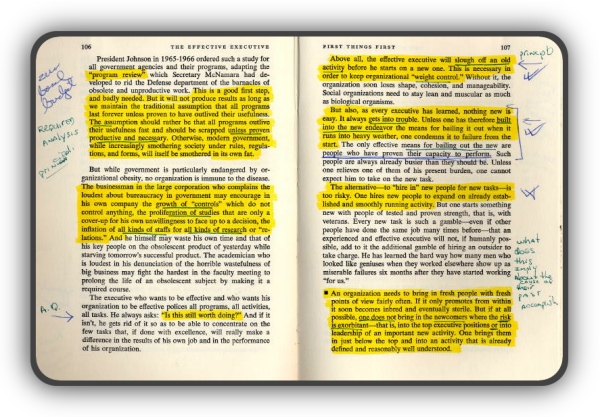
Harvesting and action thinking are needed …
Managing oneself should be the action foundation
You can select and note areas of interest. You can employ what does this mean for me? (illustration) with the PMI, dense reading and dense listening plus thinking broad and thinking detailed with operacy to see where that takes you. The potential effectiveness of our thinking depends on our existing mental landscape → see experts speak. What’s the next effective action?
Concept acquisition → action conversion → click image ↓
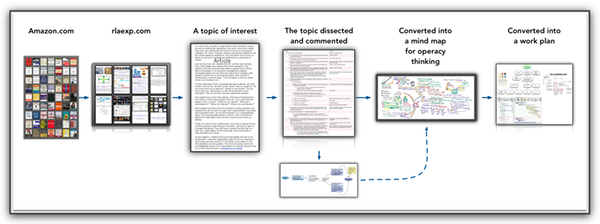
When we are involved in doing something, it is very difficult
to look outside that involvement — even when our future depends on it.
Additionally, everything eventually outlives its usefulness continue
And now for the rest of the story
Next tour stops → All sample days → Druckerisms → a major site path

The Definitive Drucker contents outline
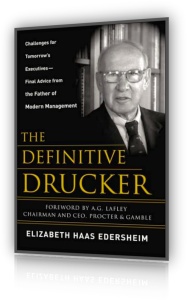
Amazon link: The Definitive Drucker: Challenges For Tomorrow’s Executives — Final Advice From the Father of Modern Management


Daily Drucker Contents
These ↓ are attention directing tools.
Sample days #sd
- January
- Integrity in Leadership
- Identifying the Future #sd
- Management Is Indispensable
- Organizational Inertia
- Abandonment
- Practice of Abandonment
- Knowledge Workers: Asset Not Cost
- Autonomy in Knowledge Work
- The New Corporation’s Persona #sd
- Management as the Alternative to Tyranny #sd
- Management and Theology
- Practice Comes First
- Management and the Liberal Arts
- The Managerial Attitude
- The Spirit of an Organization
- The Function of Management Is to Produce Results
- Management: The Central Social Function #sd
- Society of Performing Organizations
- The Purpose of Society
- Nature of Man and Society
- Profit’s Function
- Economics as a Social Dimension
- Private Virtue and the Commonweal
- Feedback: Key to Continuous Learning #mo
- Reinvent Yourself #sd #mo
- A Social Ecologist #sd
- The Discipline of Management
- Controlled Experiment in Mismanagement
- Performance: The Test of Management
- Terrorism and Basic Trends
- A Functioning Society
- February
- Crossing the Divide
- Face Reality
- The Management Revolution
- Knowledge and Technology #sd
- Shrinking of the Younger Population
- The Transnational Company
- The Educated Person #mo
- Balance Continuity and Change
- Organizations Destabilize Communities
- Modern Organization Must Be a Destabilizer #sd
- Human Factor in Management
- Role of the Bystander
- The Nature of Freedom #sd
- Demands on Political Leadership
- Salvation by Society
- Need for a Harmony of Interests
- Social Purpose for Society
- Reinventing Government
- Reprivatization
- Management and Economic Development
- Failure of Central Planning
- The Pork-Barrel State
- The New Tasks of Government
- Legitimacy of the Corporation
- Governance of the Corporation
- Balancing Three Corporate Dimensions
- Defining Business Purpose and Mission
- Defining Business Purpose and Mission: The Customer
- Understanding What the Customer Buys
- March
- The Change Leader
- Test of Innovation #sd
- Knowledge External to the Enterprise
- In Innovation, Emphasize the Big Idea
- Managing for the Future
- Innovation and Risk Taking
- Creating a True Whole #sd
- Turbulence: Threat or Opportunity?
- Organize for Constant Change
- Searching for Change
- Piloting Change
- The Purpose of a Business
- Converting Strategic Plans to Action
- Universal Entrepreneurial Disciplines
- Managing for the Short Term and Long Term
- Balancing Objectives and Measurements
- The Purpose of Profit
- Morality and Profits
- Defining Corporate Performance
- A Scorecard for Managers
- Beyond the Information Revolution
- Internet Technology and Education
- The Great Strength of E-Commerce
- E-Commerce: The Challenge
- From Legal Fiction to Economic Reality
- Management of the Multinational #sd
- Command or Partner
- Information for Strategy
- Why Management Science Fails to Perform
- Nature of Complex Systems
- From Analysis to Perception
- April
- Management as a Human Endeavor
- The Responsible Worker
- Spirit of Performance
- Organizations and Individuals
- Picking a Leader
- Qualities of a Leader
- Base Leadership on Strength
- Leadership Is Responsibility
- Absence of Integrity
- Crisis and Leadership
- The Four Competencies of a Leader
- Fake Versus True Leaders
- Churchill the Leader
- Alfred Sloan’s Management Style
- People Decisions
- Attracting and Holding People
- Picking People: An Example
- Decision Steps for Picking People
- Placements That Fail
- The Succession Decision
- Sloan on People Decisions
- A Good Judge of People?
- The Crucial Promotions
- Social Responsibility
- Sloan on Social Responsibility
- Corporate Greed and Corruption
- What Is Business Ethics?
- The Ethics of Social Responsibility
- Business Ethics
- Psychological Insecurity #mo
- May
- Managing Knowledge Workers
- The Network Society
- Global Competitiveness
- Characteristics of the Next Society
- The New Pluralism
- Knowledge Does Not Eliminate Skill
- A Knowledge Society and Society of Organizations #sd
- Price of Success in the Knowledge Society
- The Center of the Knowledge Society
- Sickness of Government
- Managing Foreign Currency Exposure
- The Manufacturing Paradox #sd
- Protectionism
- Splintered Nature of Knowledge Work
- Use of PEOs and BPOs
- Managing Nontraditional Employees
- The Corporation as Confederation
- The Corporation as a Syndicate
- People as Resources
- Making Manual Work Productive
- Productivity of Service Work
- Raising Service-Worker Productivity
- Knowledge-Worker Productivity
- Defining the Task in Knowledge Work
- Defining Results in Knowledge Work
- Defining Quality in Knowledge Work
- Management: A Practice #sd
- Continuous Learning in Knowledge Work
- Raise the Yield of Existing Knowledge
- Rank of Knowledge Workers
- Post-Economic Theory
- June
- Managing Oneself (see Sample Days) #mo
- A Successful Information Based Organization #sd
- The “Score” in Information-Based Organizations #sd
- Taking Information Responsibility
- Rewards for Information Specialists
- Hierarchy Versus Responsibility
- Sudden Incompetence #mo
- Self Renewal #mo
- Individual Development #sd #mo
- What to Do in a Value Conflict? #mo
- Place Yourself in the Right Organization #mo
- Management Education
- Attracting Knowledge Workers
- Pension-Fund Shareholders
- Pension-Fund Regulation
- Pension-Fund Capitalism
- Test of Pension-Fund Socialism
- The Business Audit
- Inflation Versus Unemployment
- When Regulation Is Required
- Work
- Goal and Vision for Work
- Self-Governing Communities
- Civilizing the City
- Human Dignity and Status
- Enjoying Work #sd#mo
- Legitimacy of Management
- Economic Progress and Social Ends
- The Social Sector
- Effective Management of Nonprofits
- July
- Theory of the Business
- Reality Test of Business Assumptions
- Synergy of Business Assumptions
- Communicate and Test Assumptions #sd
- The Obsolete Theory
- Focus on Excellence
- Creating Customer Value
- Identifying Core Competencies
- Each Organization Must Innovate
- Exploiting Success
- Organized Improvement
- Systematic Innovation
- Unexpected Success #sd
- Unexpected Failure
- Incongruity
- Process Need
- Industry and Market Structure
- Demographics
- Changes in Perception
- New Knowledge #sd
- Innovation in Public-Service Institutions
- Service Institutions Need a Defined Mission
- Optimal Market Standing
- Worship of High Profit Margins
- Four Lessons in Marketing
- From Selling to Marketing
- Cost-Driven Pricing
- Cost Control in a Stable Business
- Cost Control in a Growth Business
- Eliminating Cost Centers
- Making Cost-Control Permanent
- August
- Diversification
- Being the Wrong Size
- Growth
- Managing the New Venture
- Calculated Obsolescence
- Tunnel-Vision Innovation
- Social Innovation: The Research Lab
- Social Innovation: The Lab Without Walls
- Research Laboratory: Obsolete? #sd
- The Infant New Venture
- The Rapidly Growing New Venture
- Managing Cash in the New Venture
- Management Team for the New Venture
- Unrealized Business Potential
- Finding Opportunities in Vulnerabilities
- Exploiting Innovative Ideas
- First with the Most
- Hitting Them Where They Aren’t
- Entrepreneurial Judo
- Changing Economic Characteristics
- Ecological Niche: Tollbooth Strategy
- Ecological Niche: Specialty Skill Strategy
- Ecological Niche: Specialty Market
- Threats to Niche Strategies
- Able Company: Research Strategy #sd
- Baker Company: Research Strategy #sd
- Charlie Company: Research Strategy #sd
- Success Always Creates New Realities
- The Opportunity-Focused Organization
- Finding Opportunity in Surprises
- Maintaining Dynamic Equilibrium
- September
- Know Thy Time #mo #ee
- Record Time and Eliminate Time Wasters #ee
- Consolidate Time #ee
- Practices of Effective Executives #ee
- Focus on #Contribution #ee
- Performance Appraisals #ee
- How to Develop People #ee
- Knowledge Worker as Effective Executive #ee
- Take Responsibility for Your Career #mo
- Defining One’s Performance #mo
- Results That Make a Difference #mo
- Managing Oneself: Identify Strengths #mo
- Managing Oneself: How Do I Perform? #mo
- Managing Oneself: What to Contribute? #mo #ee
- Managing Oneself: Work Relationships #mo
- Managing the Boss #sd #sd#mo
- Managing Oneself: The Second Half #mo
- Managing Oneself: Revolution in Society #mo
- A Noncompetitive Life #sd #mo
- Staffing Decisions
- Widow-Maker” Positions
- Overage Executives
- Controls, Control, and Management
- Controls: Neither Objective nor Neutral
- Controls Should Focus on Results #sd
- Controls for Nonmeasurable Events
- The Ultimate Control of Organizations
- Harmonize the Immediate and Long-range Future #sd
- Misdirection by Specialization
- Compensation Structure
- October
- Pursuing Perfection
- Decision Objectives #ee
- Decision Making #ee
- The Right Compromise #ee
- Building Action into the Decision #ee
- Organize Dissent #ee
- Elements of the Decision Process #ee
- Is a Decision Necessary? #ee
- Classifying the Problem #ee
- Defining the Problem: An Example #ee
- Defining the Problem: The Principles #ee
- Getting Others to Buy The Decision #ee
- Testing the Decision Against Results #ee
- Continuous Learning in Decision Making #ee
- Placing Decision Responsibility
- Legitimate Power in Society
- The Conscience of Society
- Capitalism Justified
- Moving Beyond Capitalism
- The Efficiency of the Profit Motive
- The Megastate
- Purpose of Government
- Government Decentralization
- Strong Government
- Government in the International Sphere
- Needed: Strong Labor Unions
- Political Integration of Knowledge Workers
- The Corporation as a Political Institution
- Converting Good Intentions into Results
- Fund Development in the Nonprofit
- Effective Nonprofit Boards of Directors
- November
- Organizational Agility
- Business Intelligence Systems
- Gathering and Using Intelligence
- The Test of Intelligence Information
- The Future Budget
- Winning Strategies
- The Failed Strategy
- Strategic Planning
- Long-Range Planning
- How to Abandon
- Divestment
- The Work of the Manager
- Management by Objectives and Self-Control
- How to Use Objectives
- The Management Letter
- The Right Organization
- Limits of Quantification #sd
- Hierarchy and Equality
- Characteristics of Organizations #sd
- The Federal Principle
- Federal Decentralization: Strengths
- Federal Decentralization: Requirements
- Reservation of Authority
- Simulated Decentralization
- Building Blocks of Organization
- Fundamentals of Communications
- Rules for Staff Work
- Rules for Staff People
- Role of Public Relations
- Control Middle Management
- December
- The Work of the Social Ecologist
- Turbulent Times Ahead
- The New Entrepreneur
- Information on Cost and Value
- Price-Led Costing
- Activity Costing
- Obstacles to Economic Chain Costing
- EVA as a Productivity Measure
- Benchmarking for Competitiveness
- Resource-Allocation Decisions
- Six Rules of Successful Acquisitions
- Business Not Financial Strategy
- What the Acquirer Contributes
- Common Core of Unity
- Respect for the Business and Its Values
- Provide New Top Management
- Promote Across Lines
- Alliances for Progress
- Rules for Successful Alliances
- The Temptation to Do Good
- The Whistle-blower
- Limits of Social Responsibility
- Spiritual Values
- Human Existence in Tension
- The Unfashionable Kierkegaard
- Return of the Demons
- Integrating the Economic and Social
- The Family-Managed Business
- Rules for the Family Managed Business
- Innovations for Maximum Opportunities
- From Data to Information Literacy
This is a part of the conceptual resource tool kit. More “trail-heads”

These topics are attention directing tools.
The ideas introduced on this page are an early stage in calendarization—getting ideas on your radar.
Each topic that goes on your radar will need to be calendarized.
These are time investments.
It is not possible to work on things that aren’t on your active radar!!!
You need to actively work on it—calendarize it.
See September 1-3 articles for “making time.”
This book provides the means for rapidly enhancing your radar, but I can’t swear that it includes all of Drucker’s concepts and ideas.
Each day’s entry contains a source at the bottom.
You can find links to almost all of these sources on the Peter Drucker books page.

Selected quotes from the FOREWORD; PREFACE; and INTRODUCTION
... replace the quest for success with the quest for #contribution.
The critical question is not, “How can I achieve?” but “What can I contribute?”
Drucker’s primary #contribution is not a single idea, but rather an entire body of work that has one gigantic advantage: nearly all of it is essentially right.
Drucker has an uncanny ability to develop insights about the workings of the social world, and to later be proved right by history.
His first book, The End of Economic Man, published in 1939, sought to explain the origins of totalitarianism; after the fall of France in 1940, Winston Churchill made it a required part of the book kit issued to every graduate of the British Officer’s Candidate School.
His 1946 book The Concept of the Corporation analyzed the technocratic corporation, based upon an in-depth look at General Motors.
It so rattled senior management in its accurate foreshadowing of future challenges to the corporate state that it was essentially banned at GM during the Sloan era.
Drucker’s 1964 book was so far ahead of its time in laying out the principles of corporate strategy that his publisher convinced him to abandon the title Business Strategies in favor of Managing for Results, because the term “strategy” was utterly foreign to the language of business.
There are two ways to change the world: with the pen (the use of ideas) and with the sword (the use of power).
Drucker chooses the pen, and has rewired the brains of thousands who carry the sword.
When in 1956 David Packard sat down to type out the objectives for the Hewlett-Packard Company, he’d been shaped by Drucker’s writings, and very likely used The Practice of Management—which still stands as perhaps the most important management book ever written—as his guide.
In our research for the book Built to Last, Jerry Porras and I came across a number of great companies whose leaders had been shaped by Drucker’s writings, including Merck, Procter & Gamble, Ford, General Electric, and Motorola.
Multiply this impact across thousands of organizations of all types—from police departments to symphony orchestras to government agencies and business corporations—and it is hard to escape the conclusion that Drucker is one of the most influential individuals of the twentieth century.
Drucker’s genius shines best in the short paragraph or single sentence that cuts through the clutter and messiness of a complex world and exposes a truth.
Like a Zen poet, Drucker packs universal truth into just a few words; we can return to his teachings repeatedly, each time with a deeper level of understanding.
“Just go out and make yourself useful”

Assumed Background Awareness
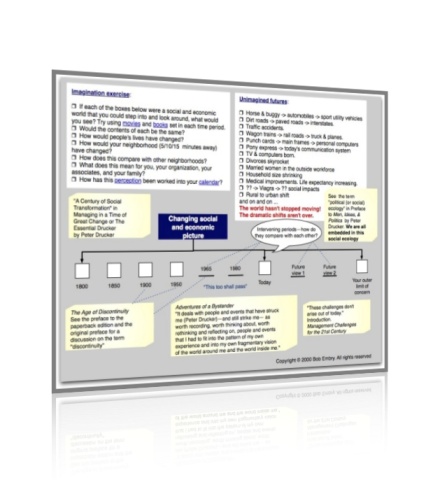
The Changing Social and Economic Picture (above)
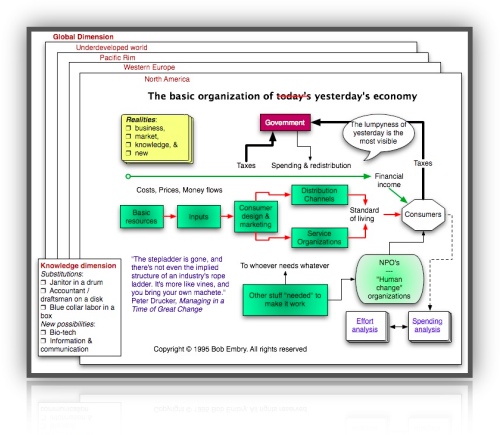
Economic Content and Structure (above)
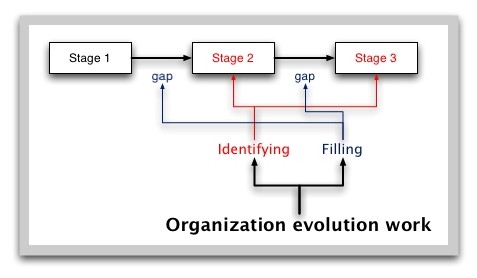
Organization evolution (above)
(consider the entire life story of Apple)
Management and the World’s Work

Larger view
Managing Oneself (above)
“This is who I am”
(the baseline for a life
embedded in
the changing social and economic picture)

These are attention directing tools.

Druckerisms — attention-directing thought jewels from PFD
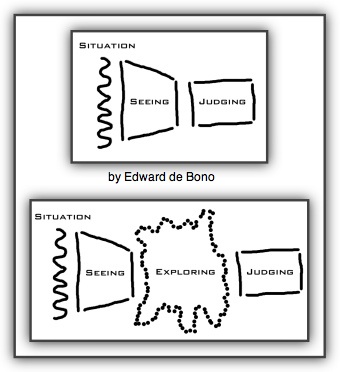
A person stands before a picture and says: ‘I like it’ or ‘I don’t like it.’
After a course on art appreciation that same person stands before a picture but now has a handful of attention directing tools:
… look at the composition;
… look at the choice of colours;
… look at the use of light and shade;
… look at the brush work;
… look at the way the clothing is treated;
… look at the background;
… look at the background figures.
After a time this richer attention scan becomes automatic.
In addition there are things that will now be noticed that may indicate a period of painting or a particular painter or a particular period of a particular painting (Picasso late period, Warhol early period).
We cannot see things unless we are prepared to see them.
That is why science advances by fits and starts as paradigms change and we are allowed to see things differently.
That is why the analysis of data can never produce all the ideas present in that data.
That is why analysis is a limited tool, not the complete one we have always believed it to be.
The James Gleick book on Chaos: Making a New Science shows how the pioneers in this field went back to look at old data but to look at it with new perceptions and could now see new things. shows how the pioneers in this field went back to look at old data but to look at it with new perceptions and could now see new things.
Edward de Bono

But the most important part of this book is the blank spaces at the bottom of its pages. They are what the readers will contribute, their actions, decisions and the results of these decisions.
I suggest a different work approach:
First don’t write in the book—figure out a way to make notes electronically.
Explore the Drucker guidance “articles” above. Rapidly read through the book (~10-15 pages per night), mark areas of interest using one of the worksheets below and do a very rough calendarization—identifying your life stages and milestones. Maybe connect each article to résumé planning. Maybe assign value and radar ratings.
Unique, sortable ratings:
Likability (the red hat): ll 5great ll 4good ll 3OK ll 2don’t~like ll 1hate~it
Timing or radar rings: rr0 rr1n7d rr2n14d rr3next rr4vsoon rr5soon rr6later rr7nxtlstage rr8last rr9aban
Value assessment (Six value medals): vv0core vv0navigating-toward vv1essential vv2-to-outline vv2important vv3interesting vv4awareness
On a worksheet the repeated characters can be dropped. The repeated characters can be used in text expansion applications to insert the remainder of the phrase
Try to discern a general pattern in your long-term interests—Early Career Work, Managing Oneself, Executive Effectiveness, Life Design, Organization Evolution etc.
At some point you probably want to veer off into The Essential Drucker. It goes into much greater depth on a shorter list of topics. Be sure to check out the introduction.
Explore the remainder (the big conceptual parts) of my Time-life navigation site to get a complete interest profile. Get organized to convert concepts to daily action.
Create mind maps for major individual topic pages (life building blocks). Thinking broad and detailed
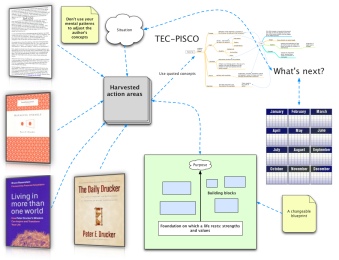
Larger view
Career and Life Guidance from Peter Drucker
is attention-directing work
In several of Drucker’s books the following appears:
“I suggest you read a chapter (topic) at a time and then first ask:
What do these issues, these challenges MEAN
for our organization and
for me as a knowledge worker, a professional, an executive?
Once you have thought this through, ask:
What ACTION should our organization and I, the individual knowledge worker and/or executive, take
to make the challenges of this chapter (topic) into OPPORTUNITIES for our organization and me?
AND THEN GO TO WORK!”
Larger view of the image below
Note the fog and reflection ↓
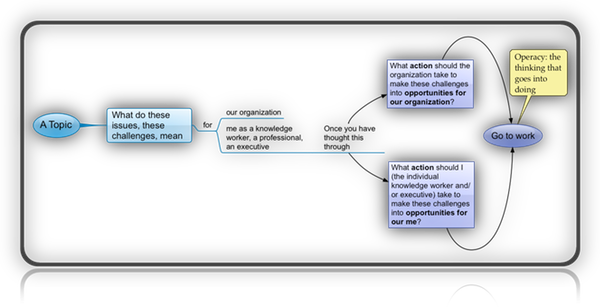
One word of advice: Look for “the future that has already happened.” If you can identify and act upon trends that are just now emerging …
“I have many times listened to Peter Drucker address executives, and I have on a few occasions seen him in action as a consultant.
In his teaching and consulting he has impressed me most by the consistency and effectiveness of the approach he uses.
First, he always makes sure he has defined the problem correctly.
Next, he seems to weave a tapestry, bringing his vast knowledge to bear upon the specific problem, and putting in “stitches,” or specific portions of the solution to the problem.
Finally, once the problem has been circumscribed and the tapestry woven, he outlines the specific actions that should be taken to solve the problem.
He then tells his audiences, “Don’t tell me you enjoyed this; tell me what you will do differently on Monday morning.”
Joseph A. Maciariello


tlnkwdailydrucker
|
![]()

![]()